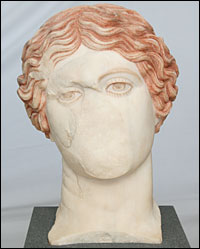
Bronze statuary was as ubiquitous in the Classical world as Starbucks are today. Ever since people began to mix copper and tin to create bronze, people shaped that bronze into useful tools or decorative ornaments. Think of bronze as the ancient equivalent to plastic if you will. Weapons, armor, statues, lamps, plumbing and everything in between was fashioned out of bronze in the Greek and Roman world. From an archaeological standpoint, bronze can be a big deal. Bronze coins and fibulae are extremely common finds and can serve as time markers, but bronze statuary is very rare and when one is found it can yield much information. In late antiquity and the middles ages, bronze (in particular bronze statuary) was melted down and turned into something considered more useful at the time. As a result, ancient bronze statues are extremely rare today and any find can greatly increase our knowledge about ancient art.
Tuesday, March 24, 2009
Catch of the Day
Posted by
Primvs Pilvs
at
2:02 PM
1 comments
![]()
Sunday, March 15, 2009
The Ancient World in Technicolor

The most common material associated with the cultures of ancient Greece and Rome is marble. Anyone who has ever visited an art museum has seen countless Greek and Roman heads, torsos and full bodied statues in all of their white, shinny austerity. The image of the ancient white marble statue is extremely pervasive and most people don't realize the truth about these magnificent works of art. Ever since artists in the Renaissance began to look at ancient statuary for artistic influence, they utilized not only the themes and styles of ancient art, but the material as well. The statues that surfaced in the Renaissance for the most part were devoid of paint due to the ravages of time, and it's the starkness of marble that inspired artists of that time. In the following centuries though, it began to be understood that these statues were painted. Statues with their paint still intact began to be uncovered and a more complete picture of what the ancient world looked like began to take shape.
Posted by
Primvs Pilvs
at
11:38 AM
1 comments
![]()







